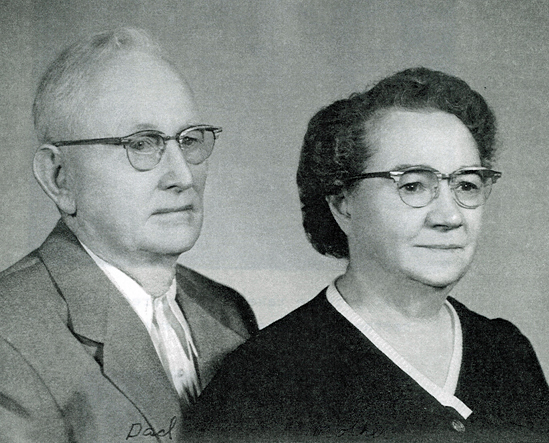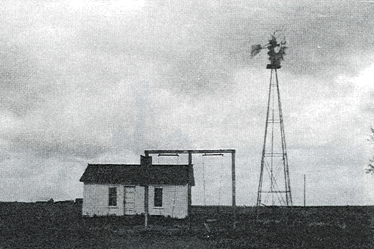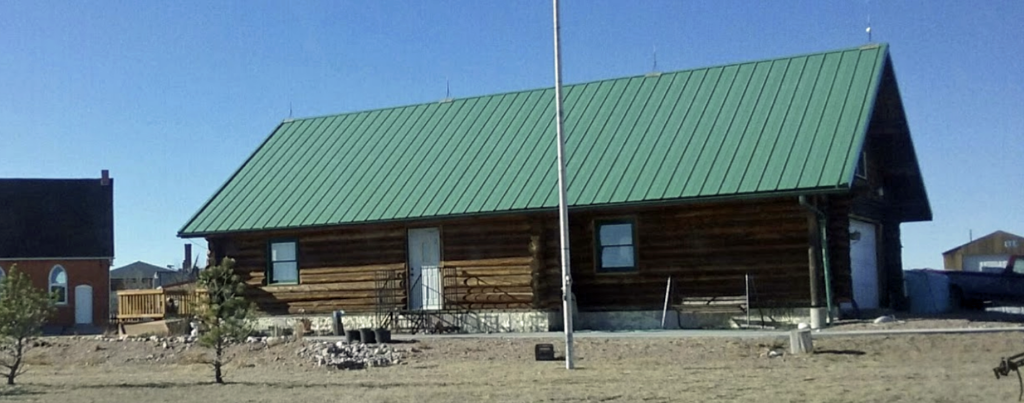Melvin (Mel) Smith Lord was born Melvin Frank Travis to Margaret and Harry Travis in Bethpage, Missouri, on October 18, 1912. Mel loved his mother, Margaret (May 7, 1885 – July 1, 1977), and maintained contact with her throughout his life. Indeed, shortly after Mel married Carmen Pagés Vilar in Barcelona, Spain, he traveled with her to Oregon and introduced her to his mother on March 8, 1942.

She was born Margaret Matilda Smith in El Dorado, Kansas, of George Washington Smith and Elizabeth Naturi Varner. Her family had been homesteading in Illinois with the Wilson family, who were traveling preachers and had left Illinois to become a part of the Cherokee Strip Homesteaders in Oklahoma. They lived in a town called Whitehead, which no longer exists. It was 10 miles from the somewhat larger town of Cage, in the western part of the territory, just below the start of the panhandle. As a young girl, Margaret worked as a midwife around Whitehead because the only doctor in the region lived in Cage and did not have time to make it to Whitehead to deliver children. This midwife experience greatly helped her in later life when she delivered her children in places lacking medical support. She met Harry when he went to their home to help dig a well.
In contrast to his fondness for his mother, Mel had a difficult relationship with his father, Harry Thomas Travis (May 27, 1876 – May 1, 1964). His father was tough on him, probably in an attempt to instill resilience to difficulties he developed in his early teenage years. Mel told my aunt, Mercedes Ribera Casamada, a story about his father that exemplified their relationship. According to Mel, his father, Harry, was once placed on a tree limb and told to jump spread-eagle into his arms. After several jumps in which he caught Mel, Harry moved aside and let Mel drop to the earth, face down and spread eagle. Fortunately, Mel did not suffer any fractures or a concussion. But emotionally, that incident hurt him deeply.
This lesson probably originated from Harry’s early experience with his brothers in logging camps located in the Allegheny mountains, described below. He probably did not mean to hurt Mel but to strengthen his son’s resolve to face adversities. Certainly, Harry’s daughters described him in narratives found in the Travis family biography as a loving man who was honest, always there for his family members to help with any problem, and willing to do anything for anyone who needed it. His actions throughout his life, as described in the Travis biography, supported those views. As Mel’s son, I too experienced many attempts by my father to toughen me up, and I now understand that they were attempts to instill positive lessons, rather than a meanness on the part of a father towards his son. Certainly, there are parallels between how Harry and my father treated his children: both were loving and caring towards their daughters but tough on their sons.
HARRY THOMAS TRAVIS
Born in the Porter Township of Jefferson County, Pennsylvania, Harry was the third child of John McCarty Travis and Mary Elizabeth Lingenfelter Travis. When Harry was a young boy, his father died from blood poisoning after accidentally cutting himself on the knee while chopping wood and refusing to see a doctor when it became infected. Because of the ensuing financial hardship to the family caused by that death, Harry was sent to live and work on the farm of the Reed family in Pennsylvania. At age 14 or 15, he left the Reed family and worked in logging camps in the Allegheny Mountains of northwest Pennsylvania with his two brothers, John and Wesley. He was said to have superhuman strength and would often brawl with other men in saloons. Without his knowledge, his brothers challenged men to fight Harry so that they could bet on him winning the fights. When, at age 17, Harry found out about those arrangements, he flew into a rage and tried to kill one of his brothers. That night, he said he cursed God for all the misfortunes that had befallen him. His subsequent remorse at having cursed God led to his becoming deeply religious.
After the breakup with his brothers, Harry made two unsuccessful attempts to join people heading west; opportunities were said to abound. On his third attempt in 1894, he made it to the Cherokee Strip in what would become the state of Oklahoma in 1907. There, he worked at the 101 Ranch, which belonged to the Miller Brothers, who had western horse shows. Afterward, after traveling to Canada and western Montana, he returned to the south to the Rio Grande Valley in Texas. He made good money and bought a horse, saddle, and a Colt 45 that belonged to the Dalton Gang and already had two notches, proving that it had been used to kill two persons.
When the Cherokee Strip Land Run took place in 1893, in which previously restricted land of the United States was opened to homestead on a first-arrive basis, Harry was there for the event. He joined 100,000 participants hoping to stake a claim to part of the 6 million acres of land and 40,000 homesteads of what had previously been Cherokee grazing land. Harry staked a claim on 160 acres of homestead land, bought another 160 acres, and became prosperous by developing a horse ranch.

While in the Territory of Oklahoma, Harry met and married Margaret on June 14, 1903, in Woodward County. Harry was 27 years old, and Margaret was 18 years old. They remained together for 32 years. Then, in 1935, they divorced when Harry was 60 years old. The events surrounding that episode in their lives are described by their granddaughter, Gertrude Totten, in her biography of the Travis family. Since it does not relate directly to Mel, interested persons can read about them in that biography. Afterwards, Margaret married Lester L. Brown on Nov 6, 1935, and Harry married Gertrude (McWhirt) Crosby on May 28, 1936. Harry and Gertrude were together until she died on June 3, 1948. Margaret divorced Lester in early 1954, and on July 15, 1954, Harry and Margaret were remarried and were together another ten years until he died in 1964. They had 9 children, 3 of whom died at birth. Mel was the 5th surviving child.
After marrying Margaret in 1903, Harry sold his land, horses and cattle and moved with Margaret to Colorado to work on a potato farm. There, they had their first child, Charles Harry, who was a surviving child of twin boys. Then, in 1905, Harry took his family to Canada, and he took a homestead in Saskatchewan Province, where he successfully grew a hardy, cold-tolerant wheat. They built a home out of blocks of sod near a lake where only two or three other families lived at the time. While in Canada, Esther and Ruth (Florence) were born. Probably due to the hardship of cold winters and the loneliness of the northern prairie for Margaret, Harry sold the homestead for a good price around 1909 and moved the family to Seattle, Washington, where he worked as a laborer, building a lodge for the family made out of Douglas Fir logs on the east shore of Lake Washington.
A year later, in 1910, Harry moved the family to Missouri, close to relatives of both Margaret and Harry in that area of Missouri and Arkansas. There, Harry developed a 40-acre apple and walnut orchard and grew other crops in a large area of land that he bought over the Arkansas border. For the next 3-4 years, the family prospered, and Margaret and Mel were born in the small town of Bethpage, Missouri, near the Oklahoma and Arkansas borders to the state. By the time they left Missouri a year later, Margaret and Harry had five children: Charles, Esther, Florence, Dorothy and Melvin.
CHILDHOOD IN A COLORADO HOMESTEAD
Around 1914, when Mel was two years old, Harry moved with his family to Greeley, Colorado, in the northern part of the state. They settled into a homestead that became their home for the next 12 years (see photos below), and he and his siblings went to school in the small town of Carr (see schoolhouse photos below). While living there, Margaret and Harry had twins who died at birth, a son who died soon after birth, and Robert, who was born in 1921. Those deaths illustrate the difficulties and hardships that Margaret faced on that land. Like most other homesteading women, she faced all the physical hardships men encountered regarding weather, illness, and danger, with the added complication of childbirth. Often, there was no doctor or midwife to aid the delivery, and many women died from treatable complications, as did their newborns. The fact that one-third of Margaret’s children died early on or during childbirth was a testament to the difficulties they faced and their bravery and pioneering spirit.

Homesteading back then relied almost completely on self-sufficiency, unlike modern homesteading, which incorporates networking support systems. Colorado, Montana, North Dakota, and Nebraska had most of the 1.6 million homestead deeds granted under the Homestead Act that President Abraham Lincoln signed on May 20, 1862. Women like Margaret lived more equitably as partners with their husbands than their Eastern counterparts. Pioneer women made important decisions and were considered by their husbands to be essential to the success of the homestead due to the necessity that all members had to work hard and contribute to the farming enterprise for it to succeed. It is, therefore, not surprising that Harry often made decisions about moving and locating the family based on Margaret’s wants and needs.
Schooling was a challenge. There was quite a distance between the Travis homestead and the town of Carr, where the Travis children went for schooling. Greeley was located a few miles southeast of Fort Collins, while Carr was north of Fort Collins in route to Cheyanne. Today, Carr is a ghost town, but the old schoolhouse survives. The area surrounding Carr was the site of many Indian battles between the Crow and Blackfeet tribes, and, in the early cowboy days, there were numerous reported gunfights between outlaws, cattle rustlers, and whites with the local Indians. It was the first stop on the Denver-Pacific Railroad from Wyoming to Colorado.
Not much information exists about the Travis family’s life in the Colorado homestead other than the photos reproduced below. However, a nearby family homestead of Fred and Elsie Livengood in the same years describes life as follows: “First, he built a barn, then Fred built a tar-paper covered shack on the land in November of 1912, and in February Elsie and their four children came to join them. After they had ‘proved up,’ the deed was drawn on February 13, 1913. They had shipped their furniture in a box car on the railroad between Cheyenne, Wyoming, and Sterling, Colorado.

“They brought with them a team of mules and two cows. In the early years, they did all their farming using teams of mules until tractors and trucks and more modern equipment were established. All the neighbors pitched in and harvested everybody’s crops when harvest came.” (Available at https://history.weldgov.com/county_150/your_stories/homesteading.) Children on farms and ranches had outside chores. Boys and girls fed chickens, hoed weeds in the garden, and helped feed and milk cows. Children began learning these chores at a young age. Boys worked in the fields with their fathers, and they herded cattle from an early age.
The fact that the Travis homestead in Colorado had a windmill (see photo) proved that it used advanced farming techniques that few others enjoyed. Most farmers used dry-farming techniques to grow corn, wheat, and sorghum. Few employed windmill technologies to draw water since the drilling and construction of windmills were an expense that few farmers could afford.
TEENAGE YEARS IN SALEM, OREGON
In May 1926, Harry sold the Colorado homestead and moved his family to Oregon. The move must have been harrowing as they went there by horseback, crossing the great Rocky Mountains for part of that long trip. Mel was 14 years old.
Initially, the Travis family stayed in Salem, and Harry worked as a laborer on a large farm. Two years later, he, Margaret and the younger children moved to Grants Pass, Oregon, 200 miles south of Salem. There, Harry bought a small piece of land to farm while Margaret worked as a cook in Wolf Creek Tavern, an important stop for stagecoaches in early Oregon days.

By then, Mel was 16 years of age, and he remained in Salem to attend high school. His mother, Margaret, became head cook in a school for blind students in Oakland, California, and she sent $25 a month to Mel throughout the school year. In the summers, he worked in a sawmill and told me of the enormous lumberjacks who worked in the camp cutting down the trees.
During the school year, he supplemented that income by working as a gardener for Clarence Morton (C.M.) Bishop, who was one of the three Bishop brothers who had developed the wool scouring plant in the town of Pendleton, Oregon. The brothers later established the popular Pendleton line of wool shirts that has continued to operate through six generations of the Bishop family.
Mel was part of a theatrical group that met at the home of Mrs. Thayer, whom they called Aunt Estelle. She had an adopted daughter who wanted to become an actress. Estelle Thayer was one of four children fathered by Asahel Bush and Eugenia Zieber of Salem. Asahel was a businessman and publisher of the Oregon Statesman newspaper. He was also the co-founder, along with William S. Ladd, of Salem’s Ladd and Bush Bank, and within a decade had taken over as sole proprietor of the institution. The Thayer family treated Mel like a family member, and he often ate with them. There, he learned to eat properly, perform housekeeping tasks, and care for the garden.